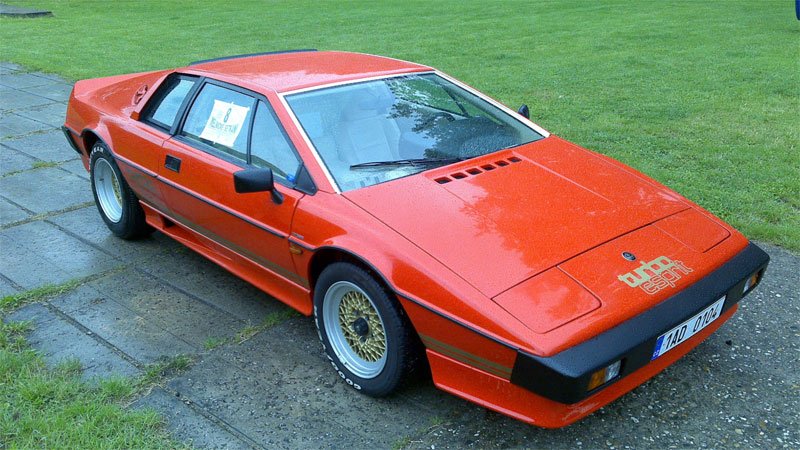Description
The Lotus Esprit Turbo was introduced in 1980 and represented a major leap forward in performance and refinement for Lotus’s flagship mid-engined sports car. Building upon the foundation established by the original Esprit S1 and S2 models, the Turbo variant transformed the lightweight wedge-shaped coupé into a genuine supercar capable of competing with Ferrari and Porsche on both speed and handling. It was also the car that firmly established the Esprit as the technological and performance centrepiece of the Lotus range throughout the 1980s.
Externally, the Esprit Turbo retained the same fundamental shape designed by Giorgetto Giugiaro but featured a number of aerodynamic and visual enhancements that set it apart from its naturally aspirated siblings. The car received a deeper front spoiler, larger side skirts, a redesigned rear section with integrated air intakes, and a wraparound rear wing that gave it a more aggressive and purposeful stance. Distinctive Turbo Esprit badging and colour-striped graphics along the body sides completed the look. These changes were not merely cosmetic — the new aerodynamic kit helped reduce lift and improved stability at high speed, an important factor given the car’s much higher performance potential.
At the heart of the Esprit Turbo was the Lotus Type 910 engine, a 2.2-litre version of the company’s proven all-aluminium four-cylinder twin-cam unit fitted with a Garrett AiResearch T3 turbocharger. This setup produced around 210 horsepower and 200 lb-ft of torque, giving the car a significant performance boost over the standard 2.0-litre model. Power was transmitted through a strengthened five-speed gearbox sourced from Citroën, driving the rear wheels. With a kerb weight of just over a tonne, the Turbo Esprit could accelerate from 0 to 60 mph in about 5.8 seconds and reach a top speed of around 150 mph, figures that placed it firmly among the fastest production cars of its day. The torque delivery of the turbo engine provided strong mid-range pull, and when the boost came on, the car delivered an exhilarating surge of acceleration.
The Turbo Esprit’s handling remained one of its defining qualities. The mid-engine configuration, low centre of gravity, and fully independent suspension with coil springs and telescopic dampers provided superb balance and control. Lotus engineers made careful revisions to the chassis geometry and damping to cope with the increased performance, resulting in a car that was both faster and more composed than earlier versions. The unassisted rack-and-pinion steering offered exceptional precision and feedback, while the car’s compact dimensions made it agile and responsive in corners. The ride quality, although firm, was impressively supple for a car of such sporting intent, maintaining Lotus’s long-standing reputation for chassis excellence.
Inside, the Turbo Esprit featured a much improved interior compared with the early S1 and S2 models. It offered deeper, more supportive leather seats, a revised dashboard with better ergonomics, and higher-quality materials throughout. The driving position remained low and intimate, reinforcing the sensation of being in a purpose-built sports machine. Air conditioning, electric windows, and improved sound insulation were standard features, reflecting Lotus’s ambition to make the Turbo not only fast but also comfortable for long-distance touring.
The Turbo Esprit gained considerable fame when it appeared in the 1981 James Bond film For Your Eyes Only, painted in white with contrasting red graphics. The car’s association with the Bond franchise further enhanced its exotic image and helped cement its status as a 1980s icon. The combination of Giugiaro’s sharp styling, the dramatic turbo performance, and its cinematic appearances made the Turbo Esprit one of the most desirable British supercars of its time.
In 1981, Lotus introduced a limited edition known as the Essex Turbo Esprit to celebrate the partnership with Essex Petroleum, the team sponsor of Lotus’s Formula One programme. These early production Turbo Esprits were finished in a distinctive blue and red livery with a full leather interior, Panasonic roof-mounted stereo system, and numbered plaques. They were followed by standard production versions that dropped the Essex branding but retained the same mechanical specification.
By the mid-1980s, the Esprit Turbo had evolved further into the Turbo HC (high compression) model, offering around 215 horsepower and improved fuel efficiency, along with detail refinements to suspension, brakes, and interior trim. The car continued to be praised for its remarkable chassis balance, vivid acceleration, and uniquely communicative steering.
The Lotus Esprit Turbo occupies a special place in the brand’s history as the car that transformed the Esprit from a lightweight sports car into a genuine high-performance grand tourer. It successfully combined Giugiaro’s striking design with Chapman’s engineering purity and became a symbol of 1980s British performance motoring. Today, it remains highly sought after for its sharp styling, thrilling turbocharged power delivery, and race-bred handling. The Turbo Esprit encapsulates everything that made Lotus distinctive — lightness, precision, and the ability to extract supercar performance from innovative engineering rather than brute force.
